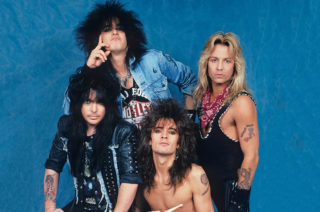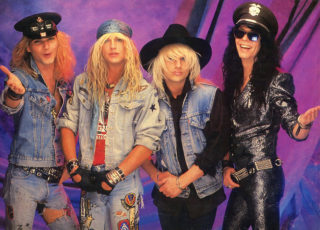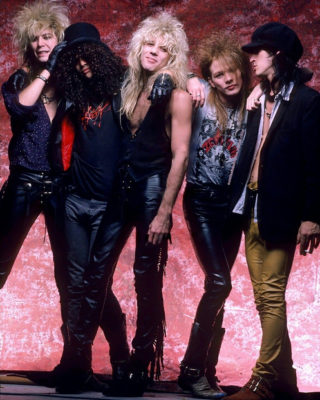Inside music’s most derided genre
The spectacular rise and fall of glam metal – there was much more to it than big cars, big hair, limos and champagne

The spectacular rise and fall of glam metal – there was much more to it than big cars, big hair, limos and champagne
Head into any pub with a pool table and a jukebox worth its salt in South West Wales and you’re likely to hear a Guns N’ Roses tune before the first break. Growing up in this sleepy corner of the UK, even the most provincial pub felt like a metal bar; places of debauchery – sonic, if not actual – that thundered from behind closed doors. More curious than the prevalence of Metallica, KoЯn or Slipknot in these towns was the underlying influence of glam metal. Mostly disregarded by critics as a blip in popular music, the belt/spandex combos, health and safety-defying pyrotechnics and acrobatic riffs of Poison and Def Leppard were nonetheless a gateway drug to the heavier stuff for many a stroppy pre-teen here. The first proper gig I can recall was seeing a GnR tribute act in Narberth’s Queen’s Hall (“Pembrokeshires [sic] number 1 hall and conference venue,” the site reads). “I bet they were a sight better than the real thing,” says journalist and writer Justin Quirk.
Despite having spent his early teens listening to the likes of Ratt and Dokken in metropolitan West London, Quirk nevertheless understands the appeal, and is likewise baffled at the wider culture’s oversight. “Glam metal was way bigger than you think,” he says. As much as his book Nothin’ But A Good Time: The Spectacular Rise and Fall of Glam Metal contains traces of his own affection for the genre taste forgot, it primarily serves as a deep dive into its history from the scrappy days of British glam to the supersized stadium juggernauts of its heyday, and a critical overhaul thereof. He continues: “Under all the rebel outsider trappings, this was 100%, down the line, nailed-on, mainstream pop music.”
Seismic shifts in early ’90s rock music are largely remembered as the sole reserve of the grunge vanguard; Kurt Cobain warbling a faux-operatic whale song as he begrudgingly performs to a backing track of ‘Smells Like Teen Spirit’ on Top of the Pops. Few care to recall that Guns N’ Roses’ ornate, bloated Use Your Illusion I sold well over twice as many copies as Nevermind in its first week. Even fewer are willing to admit that they stood in line to buy it. “You never hear anybody saying, ‘you know what, I was massively into Helloween,’” Justin says. But the numbers don’t lie: “there’s a week in the American Billboard charts where U2’s The Joshua Tree is at number one, and numbers two through ten are all glam metal albums.”
True enough, Bon Jovi’s Slippery When Wet and Poison Look What the Cat Dragged In were snapping at the heels of Bono’s pre-kinky boots in 1987. It becomes even more astonishing once you realise how little publicity went on for such groups. “These bands were selling out Wembley stadium. Aside from the odd Bon Jovi song, they were never played on daytime radio, they weren’t on TV outside of MTV or specialist late night shows,” Justin says. Really, glam metal’s meteoric rise throughout the ’80s is due in part to the fans on the ground and those who wrote for the lively subculture of metal mags – Kerrang!, Metal Hammer, Raw Power – who doggedly cultivated their audience. “Where did all these people go?” is the question Quirk asks.

Quirk had a similar proselytising mission with his book. Frustrated by the competitive strain of the publishing industry, he went with crowd-funding site Unbound, impressed by their track record of publishing books “that the mainstream don’t really get, but that there’s a big audience for.” Sure enough, the book received almost three-quarters of its funding within two weeks.
So, if the glam metal was as bloated and vacuous as it might appear, why write about it at all? “People will look at any form of culture or music, no matter how moronic, and ask, ‘why did this happen, and what’s the story?” he says, adding that, despite the emergence of critical reassessment of many forgotten “bargain bin” phenomena – from commercial house to gabber to Oi – there’s been little insight into his chosen subject. “For some reason, glam metal is the one genre that is apparently immune,” says Quirk, “but what I discovered while researching this book was that you can’t really tell the story of America in the ’80s without looking at that music, in the same way you’d struggle to tell the story of New York and LA in the ’80s without including hip-hop.”
Like hip-hop, Quirk calls glam metal a “vector” for the tumultuousness of ’80s USA; a genre that absorbed the cultural milieu as much as any genre does at any given time, only with the added dimension of immense popularity. The growth of cable TV, political optimism under Reagan, the AIDS and crack epidemics and enormous rates in poverty and unemployment were allied with the gradual halting of the Cold War. “It was possibly one of the final periods where anyone took the American Dream seriously,” Quirk says. If nothing else, glam metal was a continuation of a much longer story within American culture. Indeed, it’s difficult to imagine a group of musicians as musically unremarkable as Mötley Crüe [pictured, top] finding fame anywhere else in the world. Additionally, take Poison: “Basically pretty thick, not good looking, not original, not especially talented, but pretty good at being a band,” Quirk says. “You could be an ugly, unqualified bloke from Indiana, move to LA and essentially reinvent yourself. The story America always tells itself is of bootstrapping optimism. You start off as Paul Newman’s pool cleaner and 10 years later, you’re the highest paid star in Hollywood. But equally, the real story is that it all goes off the rails and you become part of the Manson family.”

In hindsight, the excess of glam metal was a heightened parody of this dichotomy; big cars, big hair, limos, champagne. As the ’80s progressed, the scene curdled into unpleasantness. In the book, Quirk retells a particularly horrifying anecdote from 1984. Crüe vocalist Vince Neil who, while drunk-driving with members of tourmates Hanoi Rocks, lost control of his car and hit an oncoming vehicle, seriously injuring two of his passengers and killing drummer Nicholas Dingley. The book is full of such occurrences of excess gone awry.
Guns N’ Roses were certainly not exempt. One infamous 1992 show at Montreal’s Olympic Stadium, beset by long delays and technical issues, resulted in audience riots, injuries and at least a dozen arrests. But Quirk in part credits their staying power to their willingness to “hold a mirror up to the whole scene”, revealing its squalidness as well as living within it. Nowhere is this position better presented than in the music video – the bread and butter of glam metal acts – of their breakthrough single ‘Welcome To The Jungle’. Axl Rose, dressed by all accounts as a country bumpkin down to the stalk of grain held between his teeth, alights from a bus onto the grimy streets of LA much in the way you could imagine Vince Neil doing years prior. Interspersed with scenes of ultra-violence and torture as seen on the TVs in a shop window, Rose appears performing with the rest of the band, hair tousled to the ceiling and spandex-clad like a member of Poison. By the end of the video, Rose walks away from the scenes as if to say, “this is disgusting, and it will chew you up and spit you out.”
Who else endures? While Quirk is a staunch defender of Skid Row’s 1989 debut, Def Leppard’s studio prowess (“Their best songwriting basically sounds like late ABBA to me”) and the foundational, proto-glam metal solo LPs of Ozzy Osbourne, he is adamant that Appetite for Destruction, Guns N’ Roses’ 1987 debut, is “largely untouchable. If you play someone who has no interest in glam metal Back for the Attack by Dokken, it’s not gonna mean anything. There’s a real malevolence to Appetite for Destruction. They were really horribly damaged people. A lot had gone wrong in those people’s lives to make that kind of music.”
He continues: “I wouldn’t over-stress the case too much, but I think it’s not too dissimilar to what NWA or The Geto Boys down in Houston were doing with hip-hop at the time. It’s really horrible and abusive and misogynistic and violent and bleak. Is it glorifying the culture or is it just documenting it in a very dispassionate way?” As an 11-year-old, it’s hard to tell, and that’s probably the main draw, Quirk says. “In both cases, I think now they were chroniclers rather than celebrants.”